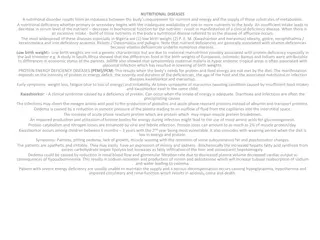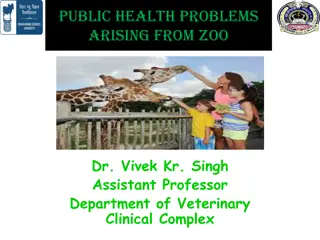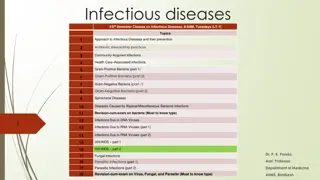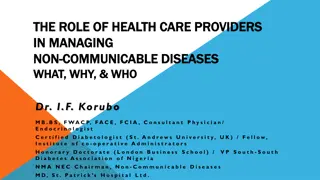Study Materials for Learning about Diseases and Telling Time
Dive into a collection of study resources covering test corrections, news updates from China, new vocabulary related to diseases, and report writing tasks. Explore new words, grammar rules for telling time, and objectives for each day of the week. Get insights on recent developments in China, includ
0 views • 13 slides
Overview of Poultry Diseases and their Causes
Poultry diseases caused by viruses and bacteria are a significant concern for poultry farmers. Viral diseases like Ranikhet Disease, Fowl Pox, and Avian Leucosis can have high mortality rates and severe symptoms. Bacterial diseases such as Tick Fever, Tuberculosis, Fowl Cholera, and Infectious Coryz
2 views • 12 slides
Periodontal Treatment Considerations for Medically Compromised Patients
Patients with significant medical conditions may require special considerations for periodontal treatment. Medical issues such as hemorrhagic disorders, renal diseases, liver diseases, pulmonary diseases, infectious diseases, pregnancy, medications, and cancer therapies can impact oral health and tr
1 views • 87 slides
Best Neurosurgery Hospitals in India
Neuro diseases are very bad diseases. Many people are caught by Neuro diseases nowadays. It is related to brain diseases. Many people in India are caught by Neuro Diseases. It happens in Adults as well as children.\nA person of any age can be affected by this. Before this time very bad disease Named
1 views • 2 slides
Overview of Nutritional Diseases and Disorders
Nutritional diseases arise from imbalances between the body's nutrient and energy requirements and their supply. Nutritional deficiencies can lead to clinical diseases, while excessive intake can result in diseases of affluence. Common nutritional disorders include low birth weight, PEM, obesity, go
4 views • 6 slides
Neonatal Diseases
Neonatal and postnatal diseases in livestock, with a focus on perinatal, neonatal, and postnatal stages. It covers common classifications, causes, and risk factors associated with these diseases, particularly focusing on neonatal diarrhea (Calf Scour). The content delves into noninfectious and infec
0 views • 33 slides
Enhancing Zoonotic Disease Risk Communication in Public Health Emergencies
Explore the significance of adopting a One Health approach to zoonotic disease risk assessment and communication in the context of emergency health situations. The session emphasizes core capacities required by the International Health Regulations (IHR) 2005, effective risk communication processes,
2 views • 13 slides
Understanding Fungal and Protist Diseases: Impacts and Prevention
Fungi and protists play significant roles as pathogens, causing diseases in both humans and plants. Fungal diseases like athletes foot and protist diseases like malaria can have serious impacts on health. Control measures such as understanding symptoms, spread mechanisms, and prevention strategies a
0 views • 10 slides
Understanding Public Health Risks Associated with Zoos and Wild Animals
Zoos and wildlife parks serve as hubs for public recreation and education but can also pose public health risks due to potential transmission of zoonotic diseases by veterinarians who work closely with wild animals. Approximately 61% of infectious agents affecting humans are zoonotic in nature, with
0 views • 15 slides
Dialysis Center Practices Survey Update for 2023
The National Center for Emerging and Zoonotic Infectious Diseases has announced changes to the Outpatient Dialysis Center Practices Survey and the Home Dialysis Center Practices Survey for 2023. The updated surveys include a new layout, clarified questions, and modifications to various sections. Fac
0 views • 20 slides
Overview of Clostridial Diseases Caused by Clostridium Bacteria
Clostridial diseases are caused by bacteria of the genus Clostridium, which are anaerobes commonly found in soil, feces, and healthy animal tissues. These bacteria can lead to various diseases in animals such as black quarter, gas gangrene, necrotic dermatitis, and more. Understanding the different
0 views • 55 slides
Managing Nutritional and Metabolic Diseases in Zoo and Wild Animals
The prevention, control, and treatment of nutritional and metabolic diseases in zoo and wild animals are essential for maintaining their health. These diseases, such as rickets, osteoporosis, osteomalacia, and fibrous osteodystrophy, can result from imbalances in dietary nutrients and metabolic dera
0 views • 10 slides
Understanding the Classification of Zoonoses
Zoonoses, diseases that can be transmitted from animals to humans, are classified based on etiological agents, transmission cycle, and reservoir hosts. Etiological agents include bacteria, viruses, rickettsial, chlamydial, mycotic, and parasitic organisms. The transmission cycle categorizes zoonoses
2 views • 18 slides
Understanding High Consequence Infectious Diseases (HCID)
High Consequence Infectious Diseases (HCID) encompass serious illnesses like Middle East Respiratory Syndrome (MERS), Ebola Virus Disease (EVD), and more. Patient screening for symptoms is crucial, and HCID is defined as diseases with high mortality rates and potential risks to healthcare personnel.
0 views • 70 slides
Understanding Brucellosis: A Zoonotic Disease Impacting Animals and Humans
Brucellosis, caused by the genus Brucella, is a zoonotic disease affecting animals like goats, sheep, cattle, and humans. It is primarily transmitted through contact with infected animals or ingestion of their products. The disease manifests in various forms like Mediterranean fever and can lead to
0 views • 13 slides
Understanding Fish Diseases and Health
Fish diseases and health are essential aspects of aquatic life. Diseases can be infectious or non-infectious, causing impairments to the normal state of fishes. Recognizing symptoms and signs of diseases is crucial for diagnosis and treatment. Overall, maintaining the health of fishes is vital for t
0 views • 21 slides
Infectious Diseases 4/5th Semester Classes: Approach & Prevention
Infectious Diseases class focuses on various topics including Antibiotic Stewardship Practices, Community-Acquired Infections, Gram-Positive and Gram-Negative Bacteria, Spirochetal Diseases, Diseases Caused by Bacterial and Viral Infections, HIV/AIDS, Fungal and Parasitic Infections. The class also
3 views • 30 slides
Overview of Rickettsial Diseases: History, Transmission, and Impact
Rickettsial diseases are caused by small, intracellular parasites primarily transmitted by arthropod vectors. This overview covers the history of these diseases, their transmission, the genera involved, and key historical events such as their impact during wars. Understanding rickettsial diseases is
0 views • 54 slides
Approach to Infectious Diseases: Antibiotic Stewardship, Bacterial Infections, and HIV/AIDS Clinical Staging
In the 4th-5th semester classes on infectious diseases, topics such as antibiotic stewardship, community-acquired infections, and various bacterial diseases are covered. The clinical manifestations and WHO clinical staging of HIV/AIDS for adults and adolescents are also discussed in detail. The cour
0 views • 29 slides
Zoonotic Diseases in Mongolia: A One Health Perspective
High risk of zoonosis in Mongolia is evident due to various factors such as livestock practices, wildlife diseases, and environmental changes. The National Center for Zoonotic Diseases in Mongolia plays a crucial role in studying, preventing, and raising awareness about over 160 zoonotic infectious
0 views • 13 slides
Understanding Zoonoses in Public Health: Classification and Transmission Cycles
Zoonoses, diseases transmitted from animals to humans, are classified based on etiological agents, transmission cycles, and reservoir hosts. The classification includes bacterial, viral, rickettsial, chlamydial, mycotic, and parasitic zoonoses. Transmission cycles are categorized as direct, cyclozoo
0 views • 19 slides
Understanding One Health and Zoonotic Diseases
Dive into the concept of One Health, which emphasizes the interconnectedness of animal, human, and environmental health. Explore the mission, leadership, and impact of the One Health Initiative, supported by major organizations like WHO, WOAH, and FAO. Learn about zoonotic diseases, how they are tra
0 views • 38 slides
Overview of Pathogenesis in Infectious Diseases
This content provides valuable information on the pathogenesis of infectious diseases, including definitions, phases of disease progression, types of infections, acute vs. chronic diseases, signs vs. symptoms, steps in pathogenesis, and ways pathogens can enter the body. It discusses the importance
0 views • 15 slides
Managing and Preventing Diseases in Pig Farming
Proper temperature regulation, ventilation, hygiene practices, and feeding are essential in reducing the risk of diseases among pigs. Indoor farming allows control over these factors but also poses a challenge if diseases do occur, potentially leading to rapid spread and significant economic losses
0 views • 8 slides
Understanding Zoonotic Hepatitis A Virus Infections
Zoonotic hepatitis A virus infections primarily affect humans and nonhuman primates, with transmission occurring through fecal-oral route. This article delves into the reservoir, mode of transmission, clinical signs, and diagnosis of hepatitis A, shedding light on its impact on both species. Nonhuma
0 views • 22 slides
Common Regulated Diseases in Imported Fruit and Vegetables
Imported fruit and vegetables can carry regulated diseases such as Citrus Black Spot, Citrus Scab, and Citrus Canker. These diseases affect citrus fruits and peppers, causing scabs, spots, and cankers, making the produce unmarketable. The pathogens causing these diseases have been intercepted in imp
0 views • 12 slides
Understanding Prion Diseases: A Comprehensive Overview
Prion diseases, such as Transmissible Spongiform Encephalopathies (TSEs), are rare and fatal neurological disorders affecting both humans and animals. These diseases are characterized by long incubation periods, neuronal loss, and the absence of an inflammatory response. Caused by abnormal folding o
0 views • 12 slides
Bovine Tuberculosis (bTB) in Michigan: Insights and Findings
Background information on the prevalence and zoonotic cases of bovine tuberculosis in Michigan, USA, highlighting statistics on infected livestock herds and wild deer over the years. The extent of zoonotic bTB cases and the achievable elimination of bTB from cattle are discussed, along with accredit
0 views • 24 slides
Lithuanian Society for Infectious Diseases: Advancing Infectious Diseases Diagnostics, Treatment, and Prevention
Lithuanian Society for Infectious Diseases is a non-profit organization in Lithuania that brings together healthcare professionals to improve the diagnosis, treatment, and prevention of infectious diseases. They participate in various initiatives, events, and collaborations, organize conferences, an
0 views • 7 slides
Molecular Investigation of Zoonotic Pathogens in Rodents of Iran
This presentation explores the molecular investigation of zoonotic pathogens such as Coxiella burnetii, Bartonella, Rickettsia, Ehrlichia, Brucella, and Borrelia in rodents of Iran. It discusses the background of zoonotic disease pathogens, disease reservoirs, characteristics of Coxiella burnetii, v
0 views • 58 slides
Understanding Infectious Diseases: Approach, Prevention, and Viral Agents
Infectious diseases play a significant role in public health, with a focus on antibiotic stewardship, community-acquired and healthcare-associated infections, as well as various bacterial, viral, fungal, and parasitic agents. Specific topics include the prevention of infectious diseases, with a deta
0 views • 18 slides
Understanding Zoonotic Diseases and Prevention Strategies
Zoonotic diseases pose a risk as they can be transmitted from animals to humans under natural conditions. Awareness of transmission routes is crucial. Direct contact, ingestion, aerosol, and indirect transmission through fomites or vectors are common means of spreading these diseases. Animals may no
0 views • 15 slides
Managing Non-Communicable Diseases: Role of Health Care Providers
Non-communicable diseases (NCDs) like cardiovascular diseases, cancers, chronic respiratory diseases, and diabetes mellitus pose significant health challenges globally. This overview delves into the definition, epidemiology, and management strategies of NCDs, emphasizing the critical role of health
0 views • 18 slides
Understanding Non-Communicable Diseases and Global Action Plans
Non-communicable diseases (NCDs), such as cardiovascular diseases, cancers, chronic respiratory diseases, and diabetes, pose a major health threat globally, with 38 million deaths yearly. The Global Action Plan aims to reduce premature mortality from NCDs by 2025 through specific targets, including
0 views • 16 slides
Understanding Paragonimiasis: A Zoonotic Disease
Paragonimiasis is a zoonotic disease caused by the Paragonimus lung fluke, primarily transmitted to humans through consumption of raw or undercooked crabs or crayfish. The disease can lead to various symptoms ranging from mild cough and abdominal pain to more severe cases affecting the central nervo
0 views • 9 slides
Understanding Infectious Diseases and Prevention Strategies
Infectious diseases are caused by pathogens like bacteria, viruses, parasites, or fungi invading the body. These diseases can spread from person to person and sometimes from animals to humans. Common characteristics include potential severe outcomes, transmission modes, and the role of pathogens. Th
0 views • 27 slides
Respiratory Diseases in Cattle: Causes, Infections, and Management
Respiratory diseases in cattle primarily stem from infectious agents such as infectious bovine rhinotracheitis and Pasteurella spp. These diseases compromise the defense mechanisms of the body, leading to infections like pneumonia and pleuropneumonia. Viruses, mycoplasmas, and bacteria like Histophi
0 views • 31 slides
Understanding Zoonotic Diseases and Mycoses
Zoonotic diseases, caused by fungi, have the potential to affect both animals and humans and are often transmitted through various environmental factors. These diseases can lead to a range of conditions affecting different organs and structures of the body. Mycoses, such as superficial and systemic
0 views • 19 slides
Understanding Occupational Diseases and Prevention Methods
This detailed training covers basic concepts of occupational diseases, types, diagnostic methods, protection measures, statistics, and legal procedures. It emphasizes the preventable nature of occupational diseases and the importance of legal responsibilities. The visuals and statistics presented hi
0 views • 49 slides
Understanding and Preventing Communicable Diseases
Communicable diseases, also known as contagious or infectious diseases, are caused by germs such as viruses, bacteria, fungi, and parasites. These illnesses spread from person to person through various means like body fluids and can have different treatment approaches. It is essential to know how th
0 views • 34 slides







































